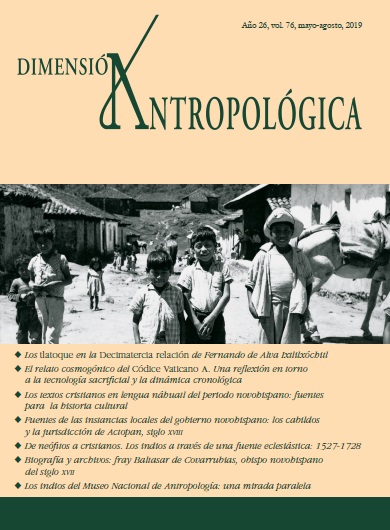Artículos
Publicado 2020-02-14
Palabras clave
- Psalmodia christiana,
- colonización,
- negociación intelectual
Cómo citar
Los textos cristianos en lengua náhuatl del periodo novohispano: fuentes para la historia cultural. (2020). Dimensión Antropológica, 76, 64-94. https://revistas.inah.gob.mx/index.php/dimension/article/view/15477
Resumen
La abundante documentación en lengua náhuatl, elaborada con fines doctrinales cristianos, nos permite conocer las transformaciones por las que atravesaron las sociedades indígenas y las relaciones establecidas entre los pueblos, corporaciones e individuos hablantes de esta lengua, con otros sectores que formaron parte de la sociedad novohispana. La Psalmodia christiana da muestra de los procesos de negociación intelectual y construcción de nuevos significados en el contexto de la colonización. Su estudio muestra la polifonía y la hibridación de diversas visiones del mundo, aspectos de sumo interés para la “historia cultural”.
Descargas
Los datos de descarga todavía no están disponibles.
Referencias
- Alcántara, Berenice, “Cantos para bailar un cristianismo reinventado: la nahuatlización del discurso de evangelización en la Psalmodia christiana de fray Bernardino de Sahagún”, tesis doctoral, UNAM, México, 2008.
- ____________, “In Nepapan Xochitl. The Power of Flowers in the Works of Sahagún”, en Joseph Connors y Gerhard Wolf (eds.) y Louis A. Waldman (colaborador), Colors Between Two Worlds. The Florentine Codex of Bernardino de Sahagún, Cambridge, Harvard University Center for Italian Renaissance Studies (Villa I Tatti), 2011 pp. 106-132.
- Anderson, Arthur J. O., “Sahagún’s Doctrinal Encyclopaedia”, Estudios de Cultura Náhuatl, núm. 16, 1983, pp. 109-122.
- ____________, “The ‘San Bernardino of Sahagún’s Psalmodia”, Indiana. Contributions to Ethnology and Linguistics, Archaeology and Physical Anthropology of Indian America, núm. 9, 1984.
- Burke, Peter, What is Cultural History?, Cambridge, Polity, 2004.
- Burkhart, Louise M., “A Doctrine for Dancing: the Prologue to the Psalmodia Christiana”, Latin American Indian Literatures Journal, vol. 11, núm. 1, 1995, pp. 21-34.
- ____________, Before Guadalupe: The Virgin Mary in Early Colonial Nahuatl Literature, Austin, University of Texas Press, 2000.
- ____________, Holy Wednesday. A Nahua Drama from Early Colonial Mexico, Filadelfia, University of Pennsylvania, 1996.
- ____________, The Slippery Earth: Nahua-Christian Moral Dialogue in Sixteenth-Century Mexico, Tucson, University of Arizona Press, 1989.
- ____________, “Introduction”, en David Tavárez (ed.), Words and Worlds Turned Around: Indigenous Christianities in Colonial Latin America, Boulder, University Press of Colorado, 2017, pp. 4-26.
- Christensen, Mark Z., Nahua and Maya Catholicisms. Texts and Religion in Colonial Central Mexico and Yucatan, Standford, Stanford University Press, 2013.
- ____________, Translated Christianities: Nahuatl and Maya Religious Texts, Pensilvania, Pennsylvania State University Press, 2014.
- Darnton, Robert, “Historia intelectual y cultural”, en El beso de Lamourette. Reflexiones sobre la historia cultural, Buenos Aires, FCE, 2010, pp. 203-235.
- Dehouve, Danièle, Relatos de pecados en la evangelización de los indios de México (siglos XVI-XVIII), México, CIESAS / CEMCA, 2010.
- Dibble, Charles E., “The Nahuatlization of Christianity”, en Munro S. Edmonson (ed.), Sixteenth-Century Mexico: The Work of Sahagún, Albuquerque, University of New Mexico Press, 1974, pp. 225-233.
- Garibay K., Ángel M., Historia de la literatura náhuatl, México, Porrúa, 2000.
- López Austin, Alfredo, “Difrasismos, cosmovisión e iconografía”, Revista Española de Antropología Americana, volumen extraordinario, 2003, pp. 143-160.
- ____________, Tamoanchan y Tlalocan, México, FCE, 1994.
- Martínez Baracs, Rodrigo, “El estudio de los indios de México durante el periodo colonial”, en Clementina Battcock y Berenise Bravo Rubio (coords.), Mudables representaciones: el indio en la Nueva España a través de crónicas, impresos y manuscritos, México, INAH, 2017, pp. 19-48.
- Mignolo, Walter, The Darker Side of the Renaissance. Literacy, Territoriality and Colonization, Ann Arbor, University of Michigan Press, 1995.
- ____________, “On Pluriversality”, recuperado de: , consultada el 7 de febrero de 2018.
- Montes de Oca Vega, Mercedes, Los difrasismos en el náhuatl del siglo XVI y XVII, México, IIF-UNAM, 2013.
- ____________, “Los difrasismos: ¿núcleos conceptuales mesoamericanos?”, en Mercedes Montes de Oca (ed.), La metáfora en Mesoamérica, México, IIF-UNAM, 2004, pp. 225-251.
- Restall, Mathew, “Filología y etnohistoria. Una breve historia de la ‘nueva filología’ en Norteamérica”, Desacatos. Revista de Ciencias Sociales, núm. 7, 2001, pp. 85-102.
- Ríos Saloma, Martín F., “De la historia de las mentalidades a la historia cultural. Notas sobre el desarrollo de la historiografía en la segunda mitad del siglo XX”, Estudios de Historia Moderna y Contemporánea, núm. 37, enero-junio de 2009, pp. 97-137.
- Sahagún, Bernardino de (fray), Psalmodia christiana y sermonario de los sanctos del año en lengua mexicana, compuesta por el muy R. Padre fray Bernardino de Sahagún de la orden de Sant Francisco. Ordenada en cantares o psalmos para que canten los indios en los areytos que hazen en las Iglesias, México, Casa de Pedro de Ocharte, 1583.
- Sell, Barry, Larissa Taylor, Asunción Lavrín, y Alonso de Molina (eds.), Nahua Confraternities in Early Colonial México: The 1552 Nahuatl Ordinances of Fray Alonso de Molina, OFM, Indiana, University of Indiana Press, 2002.
- ____________, y Louise M. Burkhart (eds.), Nahuatl Theater, 1: Death and Life in Colonial Nahua Mexico, Norman, University of Oklahoma Press, 2004.
- ____________, y Louise M. Burkhart (eds.), Nahuatl Theater, 4: Nahua Christianity in Performance, Norman, University of Oklahoma Press, 2009.
- Sell, Barry, Louise M. Burkhart, y Stafford Poole (eds.), Nahuatl Theater, 2: Our Lady of Guadalupe, Norman, University of Oklahoma Press, 2006.
- Sell, Barry, Louise M. Burkhart, y Elizabeth R. Wright (eds.), Nahuatl Theater, 3: Spanish Golden Age Drama in Mexican Translation, Norman, University of Oklahoma Press, 2008.
- Tavárez, David E., “Naming the Trinity: From Ideologies of Translation to Dialectics of Reception in Colonial Nahua Texts, 1547-1771”, Colonial Latin American Review, vol. 9, núm. 1, 2000, pp. 21-47.
- ____________, “Nahua Intellectuals, Franciscan Scholars, and the Devotio Moderna in Colonial Mexico”, The Americas, vol. 70, núm. 2, 2013, pp. 203-235.
- ____________ (ed.), Words and Worlds Turned Around. Indigenous Christianities in Colonial Latin America, Boulder, University Press of Colorado, 2017.

